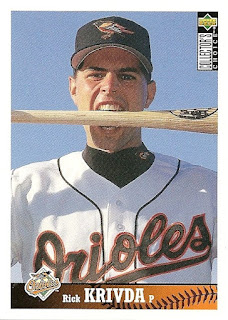
Last week, the Orioles announced that they'd resigned lefty John Parrish, who spent the first twelve years of his career in the Baltimore organization before being traded to Seattle in mid-2007 and splitting 2008 between Toronto and AAA Syracuse. If Parrish and Chris Gomez can break through the numbers game and earn spots on the Opening Day roster, they would join catcher Gregg ZAUN to form a trio of second-time Orioles. Because this is the goofy kind of trivia/minutiae that captivates me, I'm going to attempt to gather and post a comprehensive list below of players who had more than one stint in an O's uniform. In order to be eligible, they must have left the organization in between stays on Baltimore's major league roster. I'll attempt to put them in some sort of chronological order:
-Clint Courtney, C (1954, 1960, 1961): Courtney was traded to the A's in January 1961, and returned to the O's in April after just one game!
-Jim Brideweser, SS (1954, 1957)
-Don Larsen, P (1954, 1965): His eleven-year gap between Oriole stints is a team record.
-Dave Philley, OF (1955-56, 1960-61)
-Gene Woodling, OF (1955, 1958-60)
-Dick Williams, UT (1956-57, 1958, 1961-62): Clearly a favorite of Paul Richards.
-Jim Busby, OF (1957-58, 1960-61)
- Lenny Green, OF (1957-59, 1964)
-Fred Valentine, OF (1959 and 1963, 1968): Was in the Oriole organization from 1959-1963.
-Charley Lau, C (1961-63, 1964-67)
-Dick Hall, P (1961-66, 1969-71)
-Frank Bertaina, P (1964-67, 1969)
-Moe Drabowsky, P (1966-68, 1970)
-Curt Motton, OF (1967-71, 1973-74)
-Elrod Hendricks, C (1968-72, 1973-76, 1978-79): Elrod was essentially loaned to the Cubs for the 1972 pennant chase, and when he returned from the Yankees in 1978, he was essentially a coach who played in emergencies.
-Terry Crowley, OF-1B-DH (1969-73, 1976-82)
-Ross Grimsley, P (1974-77, 1982)
-Mike Flanagan, P (1975-87, 1991-92)
-Rick Dempsey, C (1976-86, 1992)
-Eddie Murray, 1B-DH (1977-88, 1996)
-Don Stanhouse, P (1978-79, 1982)
-John Flinn, P (1978-79, 1982)
-Floyd Rayford C-3B (1980 and 1982, 1984-87): Lucky Floyd! He was out of the O's organization for just one year...the 1983 championship season.
-Storm Davis, P (1982-86, 1992)
-Tito Landrum, OF (1983, 1988): The best of times...the worst of times.
-Billy Ripken, 2B (1987-92, 1996)
-Mike Devereaux, OF (1989-94, 1996)
-Mark Parent, C (1992-93, 1996): One of four second-time O's on the 1996 Wild-Card team. There were also three first-time Birds who would come back for another go-round.
-Alan Mills, P (1992-98, 2000-01)
-Richie Lewis, P (1992, 1998)
-Harold Baines, DH (1993-95, 1997-99, 2000): Had three stints each with the Orioles and the White Sox!
-Rafael Palmeiro, 1B (1994-98, 2004-05)
-B.J. Surhoff, OF-3B (1996-2000, 2003-05)
-Mike Bordick, SS (1997-2000, 2001-02): The O's traded Bordick at the deadline for a package including Melvin Mora, and then resigned the former as a free agent in the ensuing offseason. Not a bad deal!
-Sidney Ponson, P (1998-2003, 2004-05): Same as the Bordick deal, only they didn't get anything good in the trade and Ponson drank his way off the team upon his return. Awesome.
-Jeff Conine, 1B-DH-OF (1999-2003, 2006): Played twice each for the Orioles, Royals, and Marlins.
-Karim Garcia, OF (2000, 2004): Possibly the most useless two-time Oriole...0-for-16 in 2000, .212 with 11 RBI in 23 games in 2004.
-Howie Clark, OF-DH (2002, 2006)
-Luis Lopez, IF (2002, 2004)
-Steve Trachsel, P (2007, 2008): Urrrggghhh.
Whew. So that's an even forty, pending the re-arrivals of Parrish, Gomez, and ZAUN. I guess you can go home again.
 I just realized that I never told you guys about the outcome of my commercial audition for MASN. I didn't get picked, because I was too good-looking. Well, that's not what the rejection email said, but I chose to read between the lines. On the bright side, instead of spending a day stuck in some stuffy studio taping the ad, I got to stay at home and recover from the previous day's flight home from San Diego. As my new Nintendo Wii arrived in the mail that day, the timing was pretty fortuitious.
I just realized that I never told you guys about the outcome of my commercial audition for MASN. I didn't get picked, because I was too good-looking. Well, that's not what the rejection email said, but I chose to read between the lines. On the bright side, instead of spending a day stuck in some stuffy studio taping the ad, I got to stay at home and recover from the previous day's flight home from San Diego. As my new Nintendo Wii arrived in the mail that day, the timing was pretty fortuitious.



























